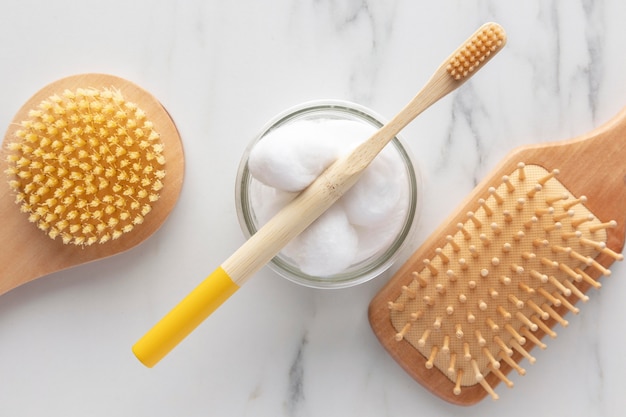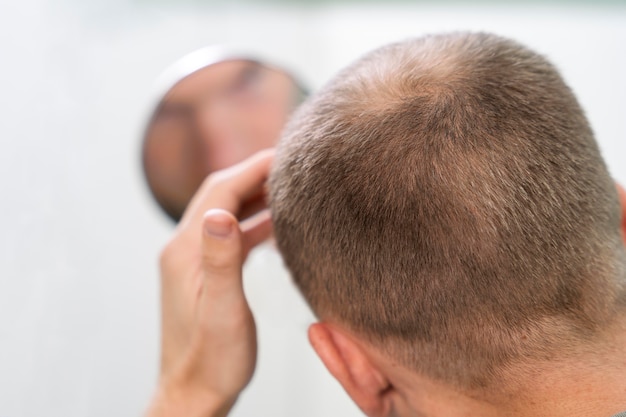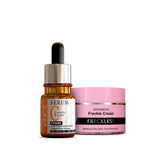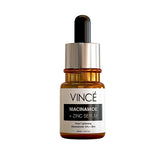Understanding Hair Loss: Causes, Types, and Prevention
Hair is indeed more than just strands on the head; it often symbolizes confidence and beauty for many individuals. So hair fall is quite alarming for people, prompting an instant quest for answers on how to stop hair fall immediately. Hair health is a matter of concern in individuals irrespective of gender and age.
Hair loss causes, types, and preventions are interlinked, and it is crucial to address hair fall solutions without giving an insight into illnesses that cause hair loss. The primary causes can be as simple as having a vitamin deficiency, or hair loss can be a sign of something serious.
So whether you're struggling with thinning hair or seeking to maintain healthy and long hair, this resource can be your helpful companion. It is here to simplify the otherwise complex subject of Hair Loss Causes, Types, and Prevention strategies.
Why is my hair falling out?
The sight of hair near the shower drain, or accumulated on the hairbrush induces stress and prompts one to search for reasons on how to stop hair fall immediately. But before delving into the hair loss causes, first analyze if it is actual hair loss or normal hair shedding.
Can hair loss be a sign of something serious? Yes, it can be. To convey the message in numbers, on average, around 40-100 hairs falling from the head is considered a regular occurrence. The fallen strands of hair symbolize that these hair have naturally reached the end of their life cycle.
Most people consider hair fall a matter of extreme concern by overlooking that our hair not only loses but also grows simultaneously. So avoid being triggered by a few hair strands falling out, as they will grow back naturally. In this case, work on preserving your hair health by utilizing hair care products like Intense Keratin Mask, designed for luxurious nourishment and vibrant hair. It stays longer on your hair for lasting impact and qualifies to prevent future hair fall.

Hair Loss Symptoms
After clearing the air about everyday hair fall and shedding light on the main signs that are bad news in the world of hair loss, we will further explain these symptoms for better understanding. Hair Loss Causes, Types, and Conventions are the latter step of a process that starts with hair loss identification.
1. Itching or pain on the scalp
When the hair loss becomes interlinked with pain or itching on your head, it is a sign of some underlying health condition. And that skin condition is the contributing factor in your hair loss.

2. Clogged drain or hairbrush
We have already cleared the ground on normal hair shedding, but actual hair loss can be unsettling. So, if your clogged drain or hairbrush view has changed drastically over time and has crossed the boundary of normal hair shedding, it is a clear sign of hair loss.

3. Bald patches
Bald patches are an issue that mostly runs in the family. The most common type is a circular bald spot on the scalp that gets wider with time.

4. Widening area or receding hairline
It is a primary sign that results in thinning hair in females, but whether it is temporary depends on the underlying cause. It begins with a subtle change in the hairline, noticeable through a receding pattern. As the hairline retreats, the affected area widens, making a visible impact on the overall density and coverage of the hair.

5. Full body hair loss
Along with the hair on your head, you start losing hair from other body parts, including eyebrows and beard.
Helpful Link: How to Protect Your Hair from Sun Damage
Types of Hair Loss And Their Causes
The fancy umbrella term for hair loss is “alopecia”, and from this originates several hair loss subtypes differentiated based on the underlying causes. These causes consist of a variable list of items, from environmental factors, psychological conditions, and genetic makeup, to name a few.
Hair strands are not mere entries on your head, but each hair goes through stages of a cycle: Growing, Resting, Falling out, and Regeneration. The sub-branches of alopecia, illnesses that cause hair loss in females or males, somehow interrupt this normal cycle or damage the hair follicle. That disturbs the harmony of hair fall rate and hair growth rate.
Listed below are a few hair loss conditions individuals often fall victim to, along with their fundamental causes.
1. Androgenic Alopecia
A significant portion of the population is facing hair loss or thinning hair solely based on this heredity condition named Androgenic alopecia.
It is one of the illnesses that cause hair loss in females and males equally and is termed the most common cause of hair loss where progressive hair loss becomes observable over time.
In males, the hair fall can start as soon as they hit puberty or can be in middle age, leading to baldness. The hair loss becomes visible above the temple and crown of the head.
In females, hair loss is witnessed around the age of 60, and hair thinning is evident throughout the scalp region.
Causes
- Genetic makeup or gene mutation
- Hormonal changes
- Age weakens the resilience of hair follicles
- Other diseases like heart disease, cancer, and PCOS in women
2. Alopecia areata
It is an autoimmune illness where an individual’s immune system mistakes its part as an invader and starts thrashing it. In response, the structures in our skin developing hair called hair follicles are attacked, resulting in bald patches or complete hair loss.
The location can vary, ranging from merely the head region or a person can lose hair from all body parts, including the scalp, face, and other body parts. Although, the hair is capable of regrowing with proper treatment or medication.
Causes
- Genetic and environmental factors
- Vitamin and mineral deficiency
3. Anagen Effluvium
It is the condition where individuals experience sudden scar-less hair shedding from the scalp region. To address these types of hair loss in females or even males, the cause of hair fall is exposure to chemicals, with chemotherapy being the most well-known reason.
The query about how to regrow thinning hair, female or male, will have to wait no longer than one to three months after the completion of their treatment. During the regrowth phase, always incorporate hair care products like Vince Re-Alive Hair Serum to witness your hair regain its smooth texture and shine.

Causes
- Radiations or chemotherapy
- Toxic chemicals or medications or infections
- Autoimmune diseases
4. Telogen effluvium
It is a condition with no signs of scars, mainly triggered by sudden changes that appeared in a patient’s routine approximately three months prior. As a result of that event, the patient loses hair from an area spread out on the scalp. The good news is that it is reversible, but pinpointing the exact factor that induced the hair loss is challenging.
As the disease has a profound attachment with a triggering event occurring within a few-month cycle, a thorough history of prior events in the patient's life proves valuable in diagnosing the root cause of hair loss.
Causes
- Physiological, like the postpartum period
- Stress
- Starvation or crash diet
- Drugs
- Organ dysfunction
- Hair dye application
- Nutritional deficiency, especially iron and zinc deficiency
5. Traction Alopecia
It is a common condition that causes hair loss characterized by localized thin hair patterns directly associated with the pressure imposed on the hair by variable factors. When a hairstyle is adopted that consistently tightens your hair, the hair loss becomes evident around that particular area of mechanical trauma.
Causes
- Hairstyle practices that exert pressure, like tight ponytails, buns, and braids
- Frequent use of chemical and thermal hair relaxing agents like straightener
- Putting on rollers overnight
Important: Early Signs of Hair Loss
Hair Loss Treatment
Life happens, and sometimes, we fall victim to different illnesses or treatment mechanisms with lasting impacts on our hair. But if the real cause is identified at the right time, it is easier to recommend relevant treatment to prevent extreme hair fall.
1. Hair transplant surgery
It is the permanent solution of hair loss where hair follicles from the scalp are extracted and transplanted on the area of patches or thinning hair.
2. Cool Caps
Cool caps are another device that is specified by physicians to avoid hair loss in many different chemotherapies.
Hair Loss Prevention
If you're seeking a quick solution on how to stop hair fall immediately, it's important to note that there is no instant remedy. But a few adjustments in daily routine, lifestyle, and behavioral changes will let you achieve the goal of healthy, strong hair that will stay on your scalp for longer.

Attractive hair that holds strength is a dream of many, and the journey of achieving this goal is built on a few do’s and don’ts in our daily practices. A detailed list is given below of a few changes you can incorporate into your daily life to witness remarkable changes.
Important: How To Reduce Frizz And Hair Loss
1. Is my shampoo suitable for preventing hair fall?
Every household owns a shampoo bottle, but have you made the right choice? A reasonable Shampoo is mandatory for hair growth as it most frequently interacts with the hair. It is a critical issue to choose the products wisely. The best anti-hair fall shampoo is characterized by its quality of cleansing your hair and scalp adequately without interfering with optimal natural oils.

- Opt for products labeled sulfate-free and paraben-free.
- Look for a shampoo with ingredients like biotin, green tea, and keratin.
- Your shampoo should align well with the cause of hair fall, i.e. dandruff, hair coloring, weak hair roots, and scalp.
2. Pay Attention To Your Hairstyle and Styling Tools
Your hairstyles should not put undue pressure on your hair, so opt for hairstyles that optimize the health of your hair and scalp. Avoid excessively tight and harsh ponytails, buns, pigtails, and braids that eventually pull out the hair before their natural life cycle ends.
Similarly, everyone wants to style their hair in unique ways. But to overly expose your hair to high-heat styling tools, whether a straightener or roller curls, drain out the strength of your hair.
3. Stay Away From Harmful Chemicals
Studies revealed that chemicals in bleach are a culprit of thin hair, mainly in females. The direct relationship between hair fall and bleach is traced back to the severe chemicals that deplete hair strength. When the hair strands are weakened, it ultimately results in reduced hair volume and increased breakage.
Similarly, before subjecting your hair to a treatment or transformation, carefully examine the probable presence of damaging chemicals.
4. Be gentle
Your hair hugely contributes to your attractiveness and deserves careful and delicate handling from your side. So be gentle in all aspects.
- Avoid harshly rubbing your hair with a towel; instead, pat them dry
- Wet hair strands are weak, so avoid excessive brushing after shower
- Use a hairbrush with natural fibers.
- Use a soft pillowcase made of silk or satin to reduce hair breakage.
5. Keep your vitamins in check
The real journey towards vibrant and healthy hair starts from your plate, so fill it with a nutrient-rich balanced diet for visible results on your skin and hair.
Which vitamin deficiency causes hair loss? The list mainly consists of vitamin D, vitamin B12, vitamin E, biotin, zinc and iron. Similarly, if the total calorie counts are insufficient, that also impacts the strength of your hair.
6. Incorporate Hair Oiling into Your Routine
Frequent washing vacates our scalp of necessary vitamins and minerals, leading to a dry scalp and damaged follicles. So, oiling has proven benefits of nullifying the harm caused by pollution and harsh chemicals and moisturizing the dry scalp.
Vince Leave-In Cream is formulated with a blend of 12 essential oils, each bringing its share of advantages to the table. Say goodbye to the dilemma of choosing the best oil among overwhelming available options, as this hair cream combines the benefits of multiple oils in one bottle.
7. Smoking is Injurious To Your Hair
Studies have revealed a strong association between smoking and weakening hair follicles. Smoking is also accused of slowing down the hair regenerative process, resulting in untimely baldness.
Helpful Link: Natural Home Remedies for Hair Loss
Conclusion
Healthy and fruitful social interactions and sound self-image are entangled with vigorous and beautiful hair. Hair loss is a complex matter of concern caused by a variable factor such as genetics, hormonal changes, lifestyle choices, and environmental exposures.
This article will be a comprehensive guide answering questions ranging from information on which vitamin deficiency causes hair loss to questions on how to regrow thinning hair in females.
While some factors are beyond our control, a mindful, proactive approach can halt hair fall. It ranges from choosing the right product for your hair, including essential oils, shampoos, and conditioners, to a proper nutritional diet.
Remember, the journey to healthier hair involves a combination of routine modifications and self-care practices. And never shy away from seeking professional guidance to address specific concerns.
Frequently Asked Questions (FAQs)
Q1. What are the types of hair loss and their causes?
The causes of various hair loss conditions can be external factors like exposure to chemicals or internal ones, including autoimmune diseases. The most common pattern of baldness in all individuals is caused by growing age, heredity, or hormonal changes. Alopecia Areata results in hair fall attributed to autoimmune diseases. Telogen Effluvium is a temporary hair fall triggered by traumatic events.
Q2. What is the main cause of hair loss?
The predominant type of hair loss is attributed to Androgenic alopecia, leading to progressive baldness in men and hair thinning in females. Almost 50% of the population fell victim to this condition, and their hair volume diminishes. It is not classified as some scalp or underlying disease but is mainly related to growing age, heredity, genetic makeup, and hormonal fluctuations.
Q3. What are the big 3 hair loss prevention?
Hair loss prevention demands a lifestyle and daily routine that keeps your hair shiny and resilient. Among the top 3 priorities, a sulfate-free and paraben-free shampoo will take the cake. Stop overexposing your hair to excessive chemicals, harsh treatments, and tight hairstyles. The presence of a well-balanced multivitamin-rich food in your diet is mandatory for effective hair loss prevention.
Q4. How do I know what kind of hair loss I have?
Determining the kind of hair loss in an individual and its underlying causes involves a comprehensive evaluation by a dermatologist or physician. These professionals make their possible judgment after considering factors like the pattern of hair loss, its extent, and any accompanying symptoms. Diagnostic tools like scalp biopsy or blood samples may also play their part in identifying the likely cause.

 KSA
KSA













